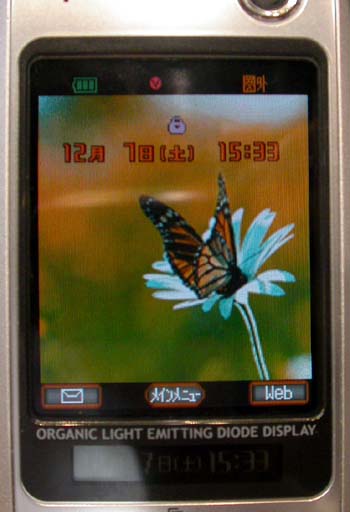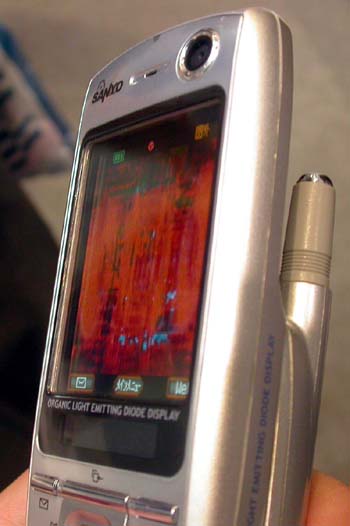|
|
Print this review
ITU Asia 2002. Live report. Part 2
Part 1
In the beginning of December 2002 one more exhibition devoted to mobile phones
was held in Hong Kong. Mainly phones from Korea and Japan were demonstrated there.
Thanks to our colleague Chan (http://xumdeo.blogspot.com)
we have an opportunity to publish a live report from this exhibition.
It's always cognitive to know an outside view, concerning this or that problem. Many of the Europeans, who will read this article, find interesting and may be someitimes contorvrsial opinions. It seems to us that some things should sound different, but it's only our opinion. Asia is another world, the other mind, other priorities, another life. You can acquainted with a small part of its life, reading the following article - next part of live report from ITU 2002.
Japanese phones
On the next booth several models, produced for FOMA networks, were showed.
NTT FOMA Toshiba T2101V – a W-CDMA video phone.

NTT FOMA SH2101V video PDA-type phone Basically it’s a PDA version of LG
G8000 with larger screen, SD slot and 310-thousand pixel camera bluetooth handset.
.

Panasonic P2101v, released a year ago? Launched with FOMA together. It's one of the first world’s 3G video-conferencing phone. But it’s too big, that’s why it’s not very popular.

D2101v by Mitsubishi is FOMA video conferencing phone with streaming video support. As for me it's not as good as Korean’s CDMA 20001x EV-DO.

P504iS Panasonic. The peculiarity of the phones is NTT DoCoMo’s I-mode service support. Besides, the handset is equipped with a dual camera and has one of the brightest screens I have ever seen.

FOMA N2002 by NEC - one of the earliest W-CDMA phones in the world (the 3rd one, to be exact). It has large size, low-resolution screen, oh c’mon, it’s released for a year!!

NEC N504iS, NTT DoCoMo I-mode specifications. It should use the same set of screen as NEC N8 except TFT is sued instead of TFD.


KZ-820 Kyocera showed a phone aimed to Chinese market. No much detail.

Sanyo also demonstrated a set of different model. Let’s see. Sanyo CDMA SCP-550 is aimed to Chinese market. It reminds me of the SCP-5300 aimed to American market and the J-S51 targeted to Japanese market. SCP-550 is CDMA (800Mhz) phone, which measures 84.5x47x23.7mm and weighs 92grams. It has 65536 color main STN display, which has a resolution of 144x120 pixels and 4096 color STN panel display, 72x72 pixels. The phone supports 16-tones polyphony and equipped with integrated 100-thousand pixels CMOS camera.


Sanyo PHS UT95 is aimed to Taiwan market. It is built for the Taiwan I-mode service.

And here is Sanyo’s dual OLED prototype.

Sanyo SA001 is a W-CDMA for j-phone’s 3G service in Japan.

Sanyo SCP-5300 and Sanyo SCP-4900 are aimed to American market. Sanyo SCP-5300 is US’ first phone with integrated camera, and the first phone with dual color displays.

It's interesitn that the First OLED main display phone in the world was produced by Sanyo. And the world’s first phone that uses OLED as side display was made by Fujitsu - Fujitsu’s F504i.
The prototype of this model from Sanyo has already been exhibited a year ago, and in CEATEC Japan 2002, the semi-working model was displayed, only with the picture taking ability. At ITU Hong Kong, I was not surprised to find this phone at Sanyo’s counter. What surprised me was the high completion of this pre-production model. The showgirls didn’t really know much about the phone, so I was talking to this senior Sanyo staff (in Japanese, of course) and I was able to get some more information out of him. There is not a specific date for this phone to be launched, but it’s targeted to AU KDDI’s CDMA2000 1x service (or probably EV-DO by them). The cost was already USD1500, so Sanyo won’t “dare” to launch this phone yet, not yet. The screen? Ok, I have to say that it’s the best screen I have ever seen, and it’s not flawless. Talk about brightness, yes, it’s very bright, as bright as sharp’s LCDs for computers, the color displayed by the OLED was VERY vibrant, almost too vibrant, that I actually thought that it was over saturated (just like LG’s LCD monitors). And in some cases, I sort of felt that the screen was “fluorescent”, and the color was too vibrant to be real. The viewing angle of the screen was very large, but do you think that actually matters? Not to me, at least. The screen was about 2.2 inches diagonally; refresh rate was very fast, comparable to plasma TV displays. I can’t say I’ll prefer OLED over Panasonic’s TFT screens, as on NTT’s Panasonic P504iS, it was nearly perfect, the color was accurate, more accurate than the OLED I saw, the resolution was high enough, and backlight was just right.
The Sanyo OLED handset itself was big, but lighter than I thought. The slide-down design was not new (or was it copied?). Dual CCD cameras of 310-thousand pixels for this prototype, but Sanyo said that they aimed for a 1MP CCD when the handset is to be released, that is the anticipated specification for NTT DoCoMo’s N505iS series to be released around autumn 2003. They may also add a SD slot to the handset, just like the Sonyericsson P802/ Nokia 3510. I was sort of let down as I was looking for a new interface, but the phone just sticked to the regular scroll-menu, with a clumsy button comparable to Fuji film’s 40i digital camera. When Samsung was releasing touchscreen handsets, and NEC is releasing handsets with track-point (the NTT FOMA N2051 by NEC announced on Dec 12; just like sub-notebooks). The handset has a built in English-Japanese/Japanese-English dictionary, which is a common feature for Japanese handsets.



There is still a long way until OLED can be put into mass production, OLED was scheduled to begin to take over TFT last year. And POOF we are here right now, where are our OLEDs? We are all fascinated by this new technology. The problem is, do we need it, are we willing to pay that much for it, or aren’t TFTs just good enough? Or how about Sharp’s “system LCD” and “3D-LCD”? The 2 types of screens Sharp developed were already put into mass production (e.g. the 176x220 dot 3D TFT display on NTT SH251iS and the 640x480 dot system-LCD display on Zaurus SL-C700). Apparently, Sharp was more successful in the market, by improving the current LCD technology rather than looking for expensive substitutes.
The year 2002 was very significant in the Japanese mobile-communication industry. Following NTT, two of the mobile service providers, the AU KDDI and J-Phone have both launched their 3G services. Not to mention the cool new phones, we saw a fascinating evaluation and diversion of services. From paying for soda to picking karaoke songs, from sending pictures to sending videos with voice, from beaming like Palms to acting as a universal remote-controller, from Java-applications to GPS service. All these imply that the Japanese mobile phone market is near to its saturation, and that service providers are trying to earn money from services rather than just voice-calls.
Owing to the fact that the number of new subscribers within the country has been dropping for more than 6 months, phone makers started to launch their cool phones overseas. The first one was the Sanyo CDMA model with 256 color screen model and 16 polyphonic melody 2 years ago. Then later this year, Panasonic released a dang-ding-dong GD87/88, which features a flip-phone design with integrated camera. Sharp did the same thing with GX10/12/18 in Europe, Hong Kong, and Taiwan. And Sanyo’s camera phone with dual color display SCP-5300 was a big hit in USA. We can see how non-Japanese are craving for Japanese phones. And this is not irrational, looking at Nokia’s 4096 color screen, or Motorola’s weak 16 polyphonic melodies, or looking at Sonyericsson’s postponed and postponed used-to-be-cool phones, or Siemens’ boring and formulated design (and nasty manu); you’ll know what gets the hype go on.
Now these western companies finally chose to imitate Japanese phones. Nokia’s 6650 was a classic wannabe, the phone featured a wannabe 4096 color STN screen, a fat, not-so-nicely designed case, a CMOS camera, and a Symbian OS without memory expansion slot. Can’t believe that it would actually be a sell out around the world. The Motorola T720 was a nice try, but the first time I saw it, I was totally shocked, I thought that the shape was dumb, and what? No MMS? And a 4096 color screen only? Geez, Motorola still has a lot to catch up.
Again, a lot of people asked, why was I-mode so successful in Japan? This is an easy question. Funny enough, the Internet penetration in Japan was not as high as expected, because they spend more time in bed, or at office working (really working, not playing icq), or in transport. And whenever they have time, they attend to their families and friends (which is a good thing). So when are they free? When they are on buses, on trains, waiting for taxis. What do they need? They need mobile Internet service, they need something small, cute and cheap… and fast! NTT has never imagined that the I-mode could be that successful, and the idea was soon borrowed to other companies. J-Phone’s J-sky, and AU KDDI’s EZWeb.
Talk about handset prices, you must be shocked to find out that you can buy a 3G phone cheaper than your Nokia 6650. Top models are usually priced at 30000 yen, which is about the same price as Motorola’s T720 in US market. But what you get is a phone with 310 thousand pixel CCD camera, 40 polyphonic, and a 2.2inch 65536 color TFT screen. It’s a different world!
The next most anticipated Japanese type phone is going to be NEC’s tri-band N8 (N525 in European markets) that features a camera, dual color displays and 40 polyphonic melody. See? We are catching up… slowly.
Chan ([email protected])
Published — 8 January 2003
Have something to add?! Write us... [email protected]
|
News:
[ 31-07 16:21 ]Sir Jony Ive: Apple Isn't In It For The Money
[ 31-07 13:34 ]Video: Nokia Designer Interviews
[ 31-07 13:10 ]RIM To Layoff 3,000 More Employees
[ 30-07 20:59 ]Video: iPhone 5 Housing Shown Off
[ 30-07 19:12 ]Android Fortunes Decline In U.S.
[ 25-07 16:18 ]Why Apple Is Suing Samsung?
[ 25-07 15:53 ]A Few Choice Quotes About Apple ... By Samsung
[ 23-07 20:25 ]Russian iOS Hacker Calls It A Day
[ 23-07 17:40 ]Video: It's Still Not Out, But Galaxy Note 10.1 Gets An Ad
[ 19-07 19:10 ]Another Loss For Nokia: $1 Billion Down In Q2
[ 19-07 17:22 ]British Judge Orders Apple To Run Ads Saying Samsung Did Not Copy Them
[ 19-07 16:57 ]iPhone 5 To Feature Nano-SIM Cards
[ 18-07 14:20 ]What The iPad Could Have Looked Like ...
[ 18-07 13:25 ]App Store Hack Is Still Going Strong Despite Apple's Best Efforts
[ 13-07 12:34 ]Infographic: The (Hypothetical) Sale Of RIM
[ 13-07 11:10 ]Video: iPhone Hacker Makes In-App Purchases Free
[ 12-07 19:50 ]iPhone 5 Images Leak Again
[ 12-07 17:51 ]Android Takes 50%+ Of U.S. And Europe
[ 11-07 16:02 ]Apple Involved In 60% Of Patent Suits
[ 11-07 13:14 ]Video: Kindle Fire Gets A Jelly Bean
Subscribe
|

















